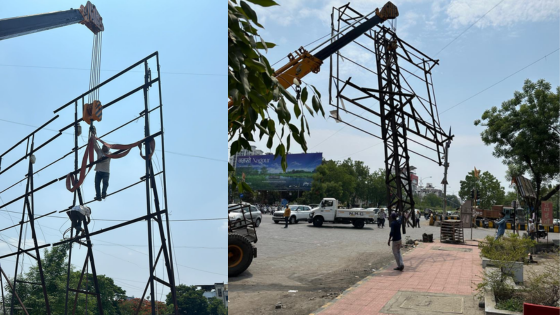NMC: 58 Illegal Hoardings on Railway Properties

illegal hoardings: The Nagpur Municipal Corporation (NMC) has embarked on a crucial mission to inspect and audit the structural integrity of hoardings across the city. This initiative was propelled by a tragic incident in Mumbai, where a hoarding collapse resulted in the loss of 16 lives. Amid these inspections, a startling revelation came to light: 58 unauthorised hoardings were discovered on railway properties. This article delves into the findings, implications, and the steps taken by the NMC to address this pressing issue.
The Mumbai Tragedy: A Catalyst for Change
The unfortunate incident in Mumbai served as a wake-up call for municipal corporations across India. The collapse of a hoarding, which claimed 16 lives, underscored the dire need for stringent checks and regulations. It highlighted the potential dangers posed by unauthorised and structurally unsound hoardings.
Nagpur’s Response: A Comprehensive Audit
In response, the NMC initiated a thorough audit of hoardings within the city. The focus was not only on ensuring compliance with existing regulations but also on assessing the structural integrity of these advertising structures.
Statistics at a Glance
- Total authorised hoardings in Nagpur: 1,054
- Hoardings inspected: 825
- Unauthorised hoardings identified: 58 (on railway properties)
- Unauthorised hoardings removed: 5 (in the initial phase)
Railway Properties: A Hotspot for Unauthorised Hoardings
A significant portion of the unauthorised hoardings was found on railway properties. These included areas such as Cotton Market, Kadbi Chowk, Tadasi, Indora Road, and Dahi Bazar Road. The railway administration had erected these hoardings without seeking permission from the NMC, leading to a breach of municipal regulations.
Key Locations with Unauthorised Hoardings
- Cotton Market
- Kadbi Chowk
- Tadasi
- Indora Road
- Dahi Bazar Road
Inspection Criteria: Ensuring Safety and Compliance
The NMC’s inspections covered several critical aspects:
Structural Strength
The primary concern was the structural integrity of the hoardings. Weak or poorly constructed hoardings pose a significant risk, especially in adverse weather conditions.
Size and Dimensions
Hoardings need to conform to specified size limits. Oversized hoardings not only violate regulations but also increase the risk of structural failure.
Location and Placement
The placement of hoardings should not obstruct visibility or pose a hazard to pedestrians and vehicles. Unauthorised hoardings often fail to meet these safety criteria.
Legal and Administrative Implications
The discovery of unauthorised hoardings on railway properties has legal and administrative ramifications. The railway administration’s failure to obtain necessary permissions is a violation of municipal laws, necessitating corrective actions.
Steps Taken by NMC
- Identification of Unauthorised Hoardings: An ongoing effort to identify and list unauthorised hoardings.
- Immediate Removal: Five unauthorised hoardings were removed within five days of identification.
- Legal Notices: Issuance of legal notices to entities responsible for erecting unauthorised hoardings.
- Coordination with Railways: Engaging with the railway administration to ensure compliance and prevent future violations.
Public Safety: The Paramount Concern
The primary goal of the NMC’s drive is to ensure public safety. Unauthorised hoardings, particularly those lacking structural integrity, pose a significant threat to public safety. By addressing this issue, the NMC aims to prevent tragedies similar to the one in Mumbai.
Community Involvement
Engaging the community in reporting unauthorised hoardings is crucial. Citizens can play a vital role in identifying and reporting illegal structures, aiding the NMC in its efforts.
Future Steps: Ensuring Compliance and Safety
Moving forward, the NMC plans to:
- Expand Inspections: Continue the inspection drive to cover all hoardings in the city.
- Stricter Regulations: Implement stricter regulations and penalties for non-compliance.
- Regular Audits: Conduct regular audits to ensure ongoing compliance and safety.
The discovery of 58 unauthorised hoardings on railway properties in Nagpur highlights a significant regulatory oversight. The NMC’s proactive approach in auditing and removing these hoardings underscores its commitment to public safety. As the city moves forward, stricter regulations and community involvement will be key to preventing such violations and ensuring a safer environment for all.
1. Why did the NMC start inspecting hoardings in Nagpur?
The NMC began inspecting hoardings following a tragic incident in Mumbai where a hoarding collapse resulted in 16 fatalities. This prompted a city-wide audit to ensure the structural integrity and legality of hoardings.
2. How many hoardings have been inspected so far?
Out of 1,054 authorised hoardings in Nagpur, 825 have been inspected for structural strength, size, and other compliance factors.
3. Where were the unauthorised hoardings found?
The 58 unauthorised hoardings were found on railway properties in areas like Cotton Market, Kadbi Chowk, Tadasi, Indora Road, and Dahi Bazar Road.
4. What steps is the NMC taking against unauthorised hoardings?
The NMC is identifying and listing unauthorised hoardings, issuing legal notices, removing illegal structures, and coordinating with the railway administration to ensure compliance.
5. How can citizens help in this initiative?
Citizens can report unauthorised hoardings to the NMC, aiding in the identification and removal of illegal structures and enhancing public safety.









